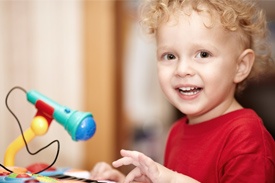 Encouraging your child to speak may lead to frustration for both you and your child. The most beneficial and fun ways to work with your child on using words can be during your daily routines. What does your child love to do with you? Singing and rhyming is a unique way to engage children in routines with built-in opportunities for communication.
Encouraging your child to speak may lead to frustration for both you and your child. The most beneficial and fun ways to work with your child on using words can be during your daily routines. What does your child love to do with you? Singing and rhyming is a unique way to engage children in routines with built-in opportunities for communication.
Some children are more likely to try to sing along to a song than to attempt to use words to ask for items around the house. Children’s songs contain a few components that make them memorable - a good beat, repeated words, associated movements and fun sounds. These help capture and hold a child’s attention.
Develop a Music Routine
Set aside time in your day to sing songs with your child. You can sing the same songs every day or switch it up between a few familiar songs. Sit face-to-face and use your body to participate in the song movements too! Since your child will be facing you, they’ll watch your facial expressions and gestures with excitement. Soon, your child will anticipate which movements or sounds will come next in a song.
Pair Actions with Specific Words
Gestures in songs are typically utilized to reinforce early language concepts like ‘open/shut’ or ‘up/down.’ Make the movements large and silly to keep your child present in the beginning. Adding routine actions and words at the end of the song, like ‘again,’ ‘up’ or ‘all done,’ will help your child learn to use gestures or words to ask for more songs or let you know if they’re finished. Using the “Clean Up” song may also help your child transition from one activity to another during other daily routines.
Take Turns and Pauses
When your child is familiar with songs, rhymes and his or her corresponding actions, you can help them participate by encouraging them to make the same movements with their body. If you think your child has the hang of the movements, it’s time to allow them to take control. The next time you sing, pause before a movement to see if your child will continue the song on their own. Your pause should be long enough to allow your child time to think about what might come next and initiate the movement or sound themselves. At the end, pause to see if your child will let you know if they want more or if they’re finished with the activity.
Create a Special Song for Your Child
You don’t have to use “real songs” to engage with your child. Take a repetitive tune you’re familiar with and add a personalized language boost! You can add your child’s name to a song and address routines like bath time, washing hands, changing diapers and getting dressed. Making songs for your own routines may help your child understand the steps of a routine, engage and take turns and express themselves.
Here are some repetitive children’s songs and rhymes that contain movement to try with your child!
- Ring Around the Rosie
- The Wheels on the Bus
Head, Shoulders, Knees and Toes - Five Little Monkeys
- The Ants Go Marching
- Itsy Bitsy Spider
- Baby Bumble Bee
- Twinkle, Twinkle, Little Star
- Baby Shark
- The Hokey Pokey
- This Little Piggy
- If You’re Happy and You Know It
- Do Your Ears Hang Low
- Row, Row, Row Your Boat









